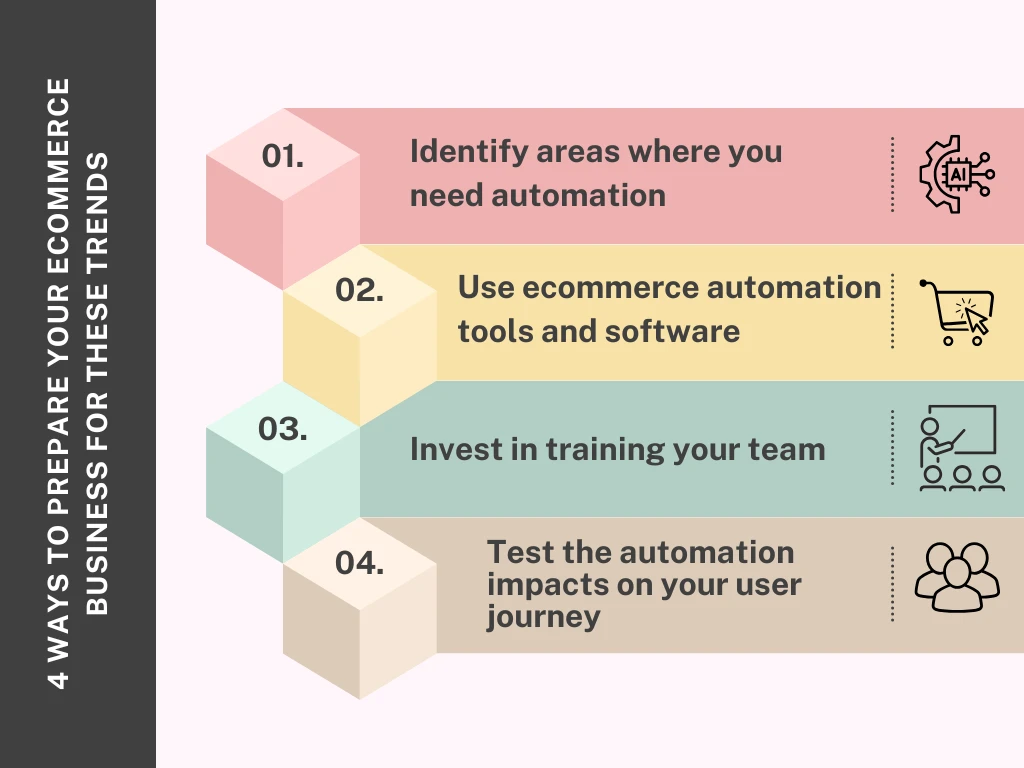The Future of Ecommerce Automation: Trends to Watch in 2025
No longer does it work when you just have the right products- today's ecommerce success depends on having the right systems in the right place. As we look ahead in 2025, automation is a must when it comes to delivering efficient, seamless, and intelligent customer experiences. It is now driving everything from customer engagement to post-sale service.
Ecommerce is evolving at the highest speed. If you are growing a brand or an established online retailer, understanding the next wave of automation trends is what you must do to stay ahead.
Let's explore 7 key trends that are shaping the future of ecommerce automation.
What is ecommerce automation?
Ecommerce automation refers to the use of technology and software that are used to streamline and automate multiple tasks and processes in online retail, including inventory management, order processing, customer support, marketing automation, and more.
Instead of relying on manual input for every function, automation allows businesses to run more efficiently while saving operational costs, scaling faster, and delivering a personalised and smoother experience. Eventually, automation is not just about eliminating manual tasks; rather, it is also about having faster, smarter, and more scalable business operations.
7 trends to watch in 2025
1. Artificial Intelligence (AI) is revolutionising the ecommerce industry
These are no longer emerging technologies; they are the driving forces that are working behind the future of ecommerce. 78% of businesses are now using AI in at least one function.
Businesses are using AI to personalise shopping experiences. AI assists in analysing browsing behaviour, purchase history, and customer preferences. The intelligent chatbots and virtual assistants can handle all customer queries while offering support 24/7.
Also, the AI-driven forecasting tools help businesses to predict sales trends, manage inventory, and reduce overstock or stockouts.
2. Sustainability is becoming a significant factor in customer decision-making
Sustainability is not just a concern nowadays, but rather an expectation. In 2025, customers who are environmentally conscious look for a brand's sustainability practices while deciding where to shop online. As per reports, 34% of global consumers are more likely to buy products with sustainable credentials.
As more and more brands are demanding recyclable, compostable, and reusable packaging, brands are investing in sustainable materials as well. Be it by offering eco-friendly packaging and materials by partnering with ethical suppliers or by offering carbon-neutral delivery options, brands are practicing sustainability in many ways.
3. Automated customer support with conversational AI is commonly used
It is becoming the standard for many ecommerce businesses. 35% of people prefer AI chatbots to answer a question or have something explained to them. As there are many advancements in natural language processing and machine learning, AI chatbots and virtual assistants are not just limited to scripted responses; they are used in solving complex issues, handling human-like conversations, and delivering support across channels.
Many AI tools can even communicate in multiple languages and operate across platforms to ensure a consistent experience. Even if there is any issue that requires a human touch, AI can transfer the conversation to a live agent with no hassle.
3. Mobile commerce is on a continuous rise
Just like the previous year, mobile commerce is dominating the ecommerce landscape in 2025 as well. As more and more customers are using smartphones and tablets to browse, shop, and pay online in an increasing way, businesses are investing in providing mobile-first shopping experiences to their customers.
From optimising the websites and apps for mobile users with responsive design and simplified checkout to offering digital payment solutions like Apple Pay, Google Pay, and one-click payment options, retailers are introducing mobile commerce in many ways. As per a report by Statista, by 2025, mobile commerce is expected to account for over 72% of total ecommerce sales worldwide, up from 58.9% in 2020.
4. Voice and video search integration is going strong in 2025
Day by day, voice and visual search are transforming the way customers are discovering products online. Shoppers prefer voice commands over typing keywords while searching products, placing orders, or checking delivery status.
Users can simply upload a photo of the item they are looking for, and the system automatically finds similar items available online. Overall, voice and visual search are providing more natural and intuitive ways to interact with online stores. If we take a look at what data says, voice is expected to be a $45 billion channel by 2028, and 62% of millennials look for the ability to use visual search over any other technology.
5. Marketing automation is getting smarter
By marketing automation, we just don't consider it as something that includes scheduling emails or running basic campaigns; it is about using AI to create a highly personalised customer journey.
AI is used to find what stage a customer is in, whether they are likely to buy or abandon a cart, and then trigger them with personalised promotion, discount, product recommendations, or loyalty offers. Marketing automation is also used in omnichannel settings to integrate seamlessly across all channels, including email, social media, and web.
6. Automation is used in order fulfillment and delivery
Automation is reshaping fulfillment and delivery nowadays. Today's customers expect transparency, reliability, and speed when it comes to placing an order. That is why businesses are also investing in automation across the fulfillment and delivery process to meet the expectations.
Nowadays, automated systems are streamlining tasks like processing orders, updating inventory, or generating shipping labels. All this allows businesses to manage higher volumes, boost consistency, and deliver a better shopping experience.
4 ways to prepare your ecommerce business for these trends
Knowing the trends is the number one step, but you need to prepare your business to deal with the rapid pace of change. Here's how you can future-proof your business.

1. Identify areas where you need automation
You need to start by reviewing your current workflow. This will help you to pinpoint repetitive and time-consuming tasks like order processing, customer support, or inventory updates. Understanding all these will help you to prioritise the areas that will get the highest benefit from automation.
2. Use ecommerce automation tools and software
Choosing the right tools is a necessary step you must take to automate the tasks once you have identified the gaps. As there are many platforms available, select tools that offer automation features like marketing, inventory, order management, and customer engagement.
3. Invest in training your team
When it comes to adopting automation, it requires more than software; you must have a team that understands how to use it effectively. So, to train your staff so that they can monitor, manage, and adapt these systems. Once you get a well-trained team, they can add value to your investment.
4. Test the automation impacts on your user journey
Do not just set it and forget it once you are done with implementing automation. Keep a track of how the automation is affecting your customer experience. Focus on the key areas like response times, page speed, and checkout flow to make sure automation is enhancing.
Bonus point: Automation is no longer optional
Let's just face it, in the era of modern ecommerce, manual processes can't keep up. Speed, personalisation, and hassle-free experiences are what today's shoppers need. That is why automation is not just some 'nice-to-have' feature, but rather becoming the backbone of many successful online businesses.
So, make automation your next move to stay one step ahead and start your journey.



![How to Start an Ecommerce Business in Australia [2023 Guide]](/template/5731a701/images/resource-blog-right-img1.png)





